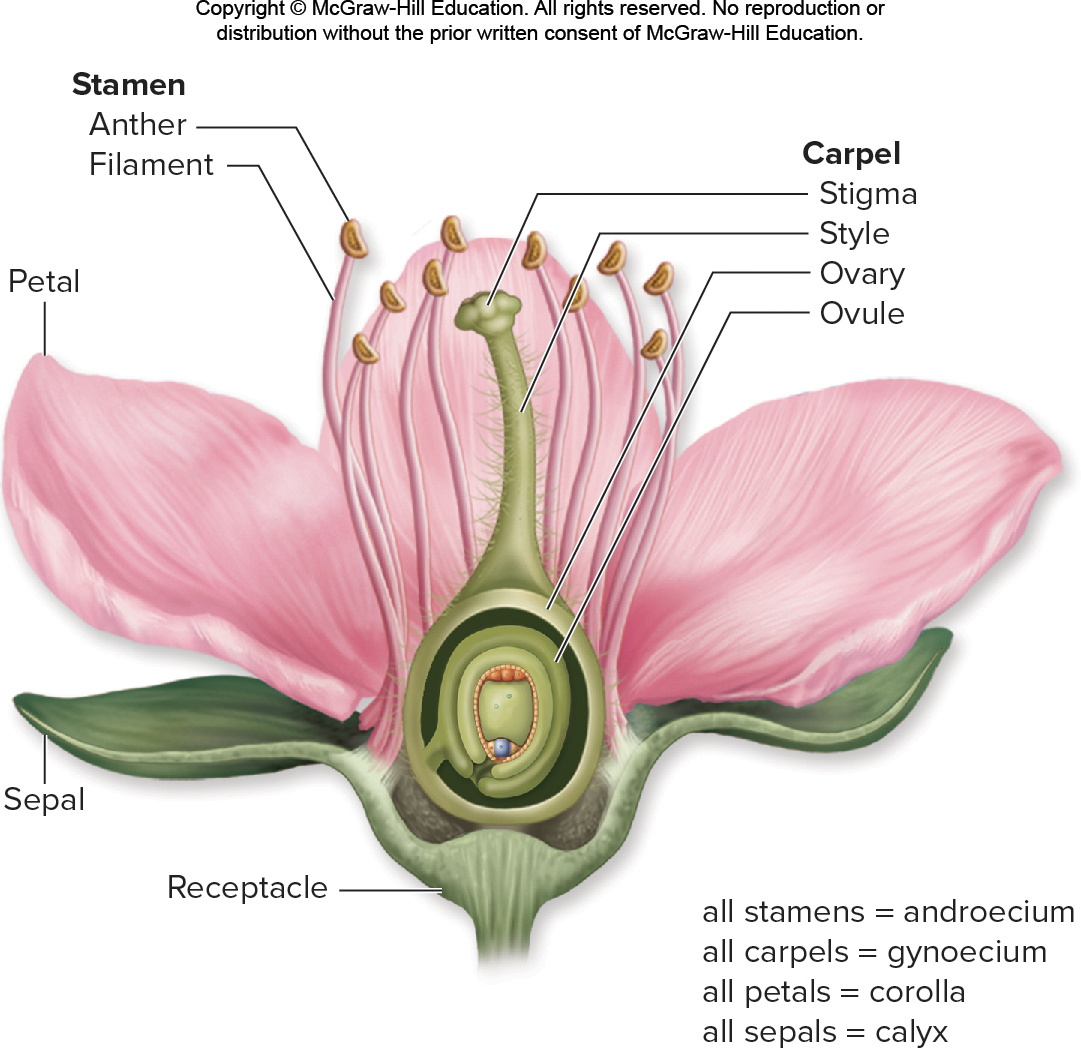Plant Reproduction
Plant Reproduction

Flower Production
Four genetically regulated pathways to flowering have been identified
- The light-dependent pathway
- The temperature-dependent pathway
- The hormone-dependent pathway ((gibberellin)
- The autonomous pathway (epigenetic and post-transcriptional)
Plants can rely primarily on one pathway, but all four pathways can be present
Flower Structure
Floral organs are thought to have evolved from leaves
A complete flower has four whorls
- Calyx, corolla, androecium, and gynoecium.
An incomplete flower lacks one or more of these whorls.

Trends in Floral Specialization
2 major trends floral specialization:
- Floral parts have grouped together
- Floral parts lost or reduced
Modifications often relate to pollination mechanisms
\n
Trends in floral symmetry:
Primitive flowers are radially symmetrical
Advanced flowers are bilaterally symmetrical
Trends in Pollination
Process by which pollen is placed on the stigma
Self-pollination
- Pollen from a flower’s anther pollinates stigma of the same flower.
Cross-pollination
- Pollen from anther of one flower pollinates another flower’s stigma.
- Also termed outcrossing.
Successful Pollination
- Successful pollination in many angiosperms depends on regular attraction of pollinators
- Floral morphology has coevolved with pollinators
- Early seed plants wind pollinated
- Among insect-pollinated angiosperms, the most numerous groups are those pollinated by bees
Bee Pollination
- Bees typically visit yellow or blue flowers
- Many have stripes or lines of dots that indicate the location of the nectaries (specialized nectar-producing structures).
Other Pollinators
- Flowers that are visited regularly by butterflies often have flat “landing platforms”
- Flowers that are visited regularly by moths are often white or pale in color and also tend to be heavily scented, making them easy to locate at night
- Flowers that are visited regularly by birds must produce large amounts of nectar
- Often have a red color
- Conspicuous to birds, but usually inconspicuous to insects.
Wind Pollination
Some angiosperms are wind-pollinated
- Characteristic of early seed plants.
Flowers are small, green, and odorless, with reduced or absent corollas
Often grouped and hanging down in tassels
Stamen- and carpel-containing flowers are usually separated between individuals
- Strategy that greatly promotes outcrossing.
Seeds
- In many angiosperms, development of the embryo is arrested soon after meristems and cotyledons differentiate
- Integuments develop into a relatively impermeable seed coat
- Encloses the seed with its dormant embryo and stored food
Initiation of Germination
- Germination: the emergence of the radicle (first root) through the seed coat
- Germination cannot take place until water and oxygen reach the embryo
- Stratification: some seeds require periods of time at low temperatures before germination
Food Storage in the Seed
- Germination and early seeding growth require the metabolism of energy reserves (starch)
- Scutellum: in kernels of cereal grains (monocots), the single cotyledon is modified into this structure, which transfers nutrients from the endosperm to the embryo
Hormonal Effects
- In response to the absorption of water by a seed, the embryo produces gibberellins.
- This signals the outer layer of the endosperm to produce amylase
- Amylase digests starch.
- Levels of abscisic acid (another hormone that produces seed dormancy and starch breakdown ) may be reduced when a seed absorbs water
Asexual Reproduction
- Produces genetically identical individuals because only mitosis occurs
- More common in harsh environments.
- Apomixis – asexual development of a diploid embryo in the ovule.
- Other interesting (and useful) variations to the life cycle:
- Parthenocarpy – inducing fruit formation w/o fertilization w/in the ovule (can be induced in some hormones applied artificially.
- Stenospermocarpy – fertilization occurs but development is aborted (for example, some cultivars of seedless grapes).
Vegetative Reproduction
New plant individuals are cloned from parts of adults
Comes in many and varied forms
- Runners or stolons.
- Rhizomes.
- Suckers.
- Adventitious plantlets.
Plant Life Spans
- Once established, plants live for variable periods of time, depending on the species
- Woody plants, which have extensive secondary growth, typically live longer than herbaceous plants, which don’t
- Bristlecone pine, for example, can live upward of 4,000 years.
- Depending on the length of their life cycles, herbaceous plants may be annual, biennial, or perennial
Annual, Biennial, or Perennial
Annual plants grow, flower, and form fruits and seeds within one growing season
- They then die when the process is complete.
Biennial plants have life cycles that take two years to complete
- Store energy in year one, flower in year two.
Perennial plants continue to grow year after year
- They may be herbaceous or woody.